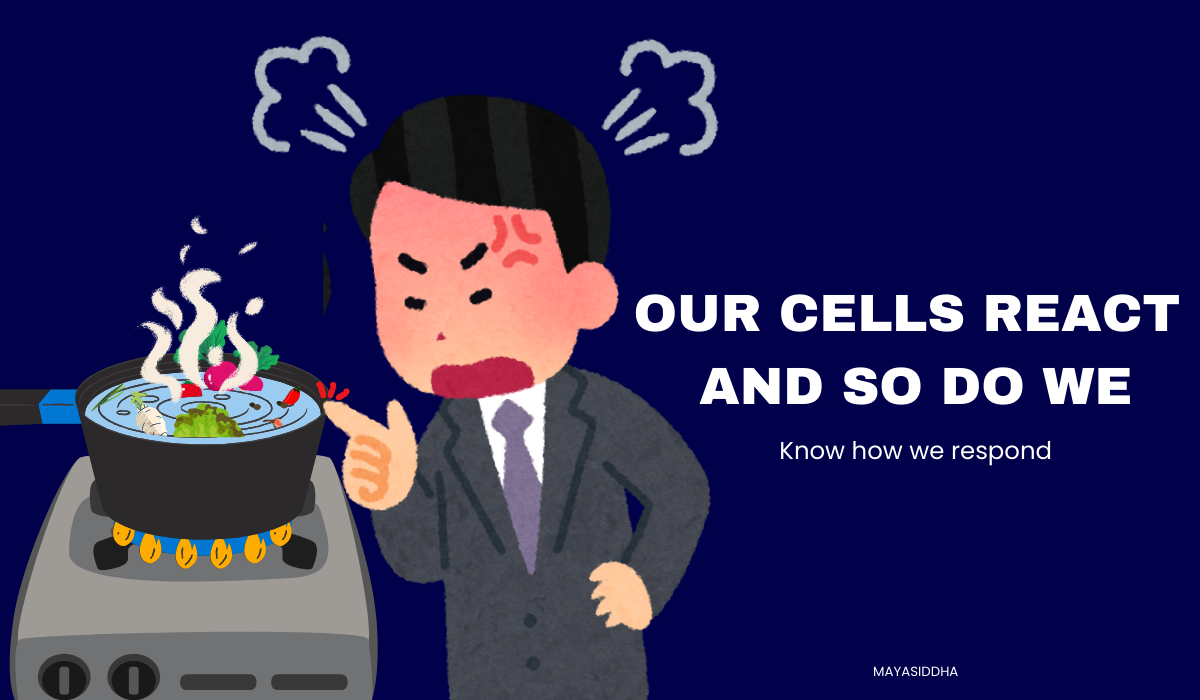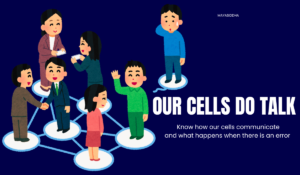Introduction
We know when we touch a hot pan, we immediately pull our hand away. This quick reaction happens because our cells rapidly communicate the sensation of heat and induce a quick response. Types of sensory receptors
Types of sensory receptors
To avoid communication errors, our cells use a mediator to ensure messages are accurately delivered to the right cell. In this blog, we’ll see how this mediator eases cell communication and helps us react.
First, let’s take a brief look at cell communication.
Cell communication
We: As we are made of numerous cells, they must communicate with one another to work together and function effectively. Cells do this by sending signals a.k.a ligands or signalling molecules like how we send messages to communicate.
Communication: The cell that sends a signal is called a signalling cell while the one that receives that signal is called a target cell. The signalling cell sends a signal to the target cell, which receives it via its receptor and in response to that received signal, the target cell modifies its function.
Secret code: Ligands and receptors are specific to each other much like a lock and key. They play a crucial role in cell communication.
Lock: Receptors act like mediators in cell communication by receiving and delivering signals properly. They receive the signal like a receiver and deliver that message to the target cell like a messenger.
Key: The signals that bind to the receptor can be Chemicals, Gases, Ions, Adenosine, Drugs and Toxins. Without a ligand or with the default receptor, cell communication breaks down.
If you wanna know more about cell communication, you can refer here. Now let’s explore the hero of this blog; the mediator in detail.
Who is that mediator?
Receptors are nothing but proteins present inside the cell and on the cell membrane. We have numerous receptors that are specific to each cell and they function like a mediator, a bridge between the signalling cell and the target cell.
Duality: Receptors act like mediators and at the same time, they also function like sensors, which help us to adapt to the changing external environment and maintain homeostasis.
Receptors are like locks with a specific shape, designed to bind, only to the signalling molecules that perfectly match their shape.
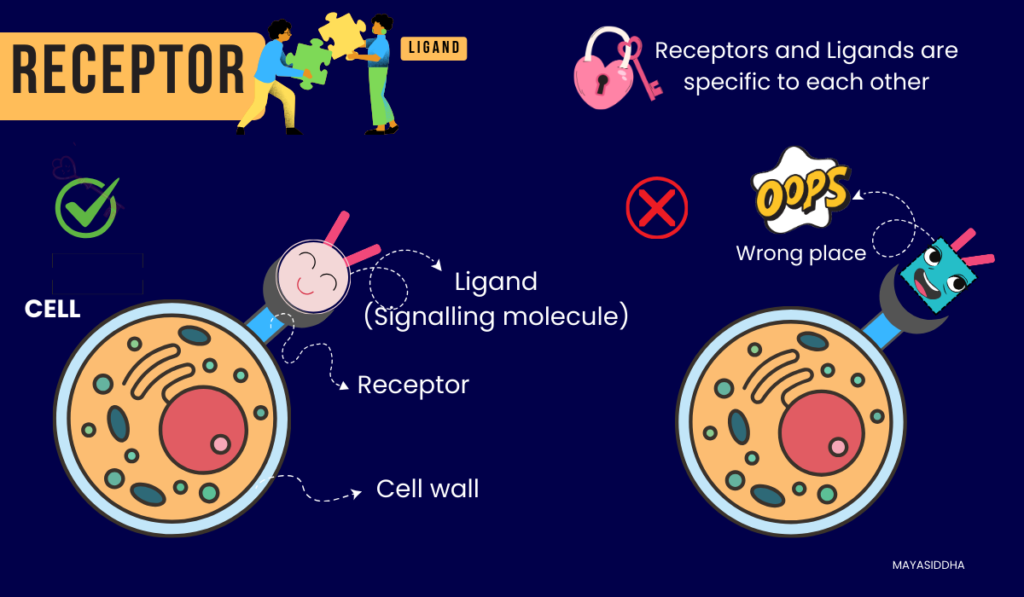
Previously we saw that we have numerous receptors, now let’s classify them.
Types of Mediator
We can categorise the receptors based on their location and function into Cellular receptors and Sensory receptors respectively.
Cellular receptors
Cellular receptors can further be classified into Intracellular and Intercellular receptors based on their location.
1. Intracellular receptor
These receptors are found inside the cell and thus take part in Intracellular communication. The signalling molecule that is produced within the cell or the one that crosses the cell membrane, binds to this receptor and induces a change that either turns on or off certain genes.
These receptors are further divided into –
- Cytoplasmic receptor – Present in the cytoplasm
- Nuclear receptor – Present in the nucleus
2. Cell membrane receptor/Transmembrane receptor
These receptors are located on the cell membrane. The signalling molecule produced by the signalling cell binds to this receptor and either activates or inactivates the receptor-linked functions on the target cell. These receptors engage in Intercellular communication.
These receptors are further classified into –
(a) Ion channel-linked receptor
When a ligand binds to this receptor, in response to that signal, the target cell opens its door and allows ions to enter the cell. It is also called a Ligand-gated ion channel.
(b) G-protein coupled receptor
When a ligand binds to this receptor, firstly the G-protein which is present on the cell membrane gets activated and undergoes structural change.
Then it activates a series of reactions in the target cell and eventually, it results in functional modification of that cell.
Eg. when the Adenosine ligand binds to the Adenosine receptor on the target cell, in response to that signal the cell’s activity slows down which in turn makes us sleep.
This activated G-protein can also activate Ion channel-linked receptors or Enzyme-linked receptors based on the binding ligand.
(c) Enzyme-linked receptor
When a ligand binds to this receptor, the enzyme linked to that receptor gets activated which in turn induces a series of enzymatic reactions and in the end, the function of the target cell is modified in response.
Eg. Insulin receptor. When the insulin ligand binds to the insulin receptor on the target cell, it induces a series of reactions and in response to that signal, the cell opens its door and allows glucose to enter the cell.
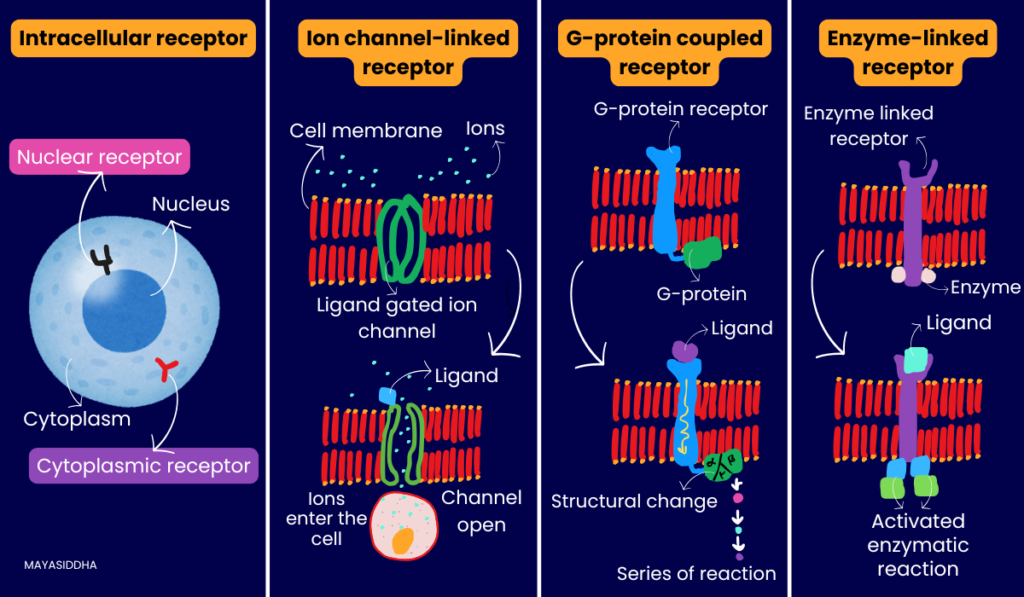
The Hero, Receptor: Receptors are the stars in the pharmaceutical field because they interact with drugs and induce a specific response accordingly.
For eg. Under normal circumstances, when the Angiotensin II hormone binds to the Angiotensin II receptor, it raises blood pressure by constricting the blood vessels.
If our blood vessels are filled with plaques, this normal constriction feels overwhelming and it leads to increased blood pressure. To remove the plaques and reduce the pressure, we may need medicines.
Angiotensin II receptor blockers (ARBs) are medicines used to reduce pressure. These drugs bind to the angiotensin II receptor in the place of that hormone and reduce blood pressure by relaxing the constricted blood vessels.
Thus, it’s clear that receptors and ligands play a crucial role in cell communication and modifying cell activity. When there comes an error in receptor-ligand binding, we become dis-eased.
Sensory receptors
Sensory receptors are present in the eyes, nose, ears, mouth, skin and some internal organs. They detect senses – Vision, Smell, Hearing, Taste, Touch, Pain, Temperature, Vibration and Pressure.
Everything in this world is about “SURVIVAL OF THE FITTEST”. To survive better, we must adapt to the changes. These sensory systems help us maintain our internal balance and adapt to changing environmental conditions.
The sensory signals are detected by the sensory receptors and carried forward to our brain which help us respond and adapt to the changes within our body and to the changing external environment.
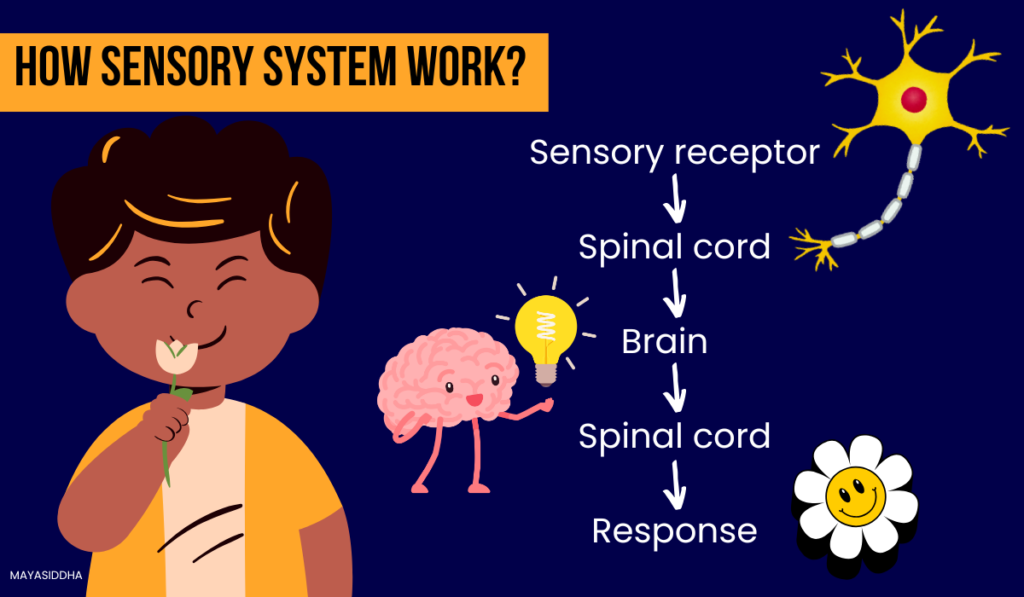
Types of sensory receptors
1. Photoreceptor
Present in the Eyes and it detects light. With the help of this receptor, our body senses light and regulates our Circadian rhythm.
2. Olfactory receptor
Detect smell and are present in the Nose.
3. Chemoreceptors
They detect the changes in levels of oxygen, carbon dioxide and Ph in the blood which prevents us from falling into conditions like hypoxemia etc.
These receptors can also detect taste and smell via the chemicals present in food and volatile substances like medicated oils etc.
E.g. The taste receptor present in the tongue detects taste.
4. Mechanoreceptors
They are present in the skin, heart, brain, muscles, bones etc and they detect variations in mechanical energy – pressure, vibration, movement etc. With the help of these receptors, we detect the changes in the environment and adapt to them.
That’s how our body detects variations in the solar magnetic field. If you wanna know more about how the solar magnetic field affects humans and causes heart attacks, you can refer here.
E.g. Baroreceptors – They are present in the heart and in the blood vessels near the heart, lungs etc. They detect variations in blood pressure.
Proprioceptor – Detect the position and movement of our body which helps us know how our body is moving and positioned. They are present in the Ears, muscles, joints, skin etc.
5. Thermoreceptor
Detect temperature and are present in the Skin. With the help of this receptor, our body detects the temperature variations in the environment and maintains our body temperature accordingly.
These receptors also detect the temperature variations within our body which helps us maintain our temperature within the normal range.
E.g. In hot climates, we sweat, which keeps our body cool and it is one of the survival mechanisms of our body to withstand this environmental condition.
During high fever, we sweat, which keeps our body cool and brings the raised temperature back to the normal range. In both scenarios, we were able to adapt and respond to the change with the help of the thermoreceptors. Types of sensory
6. Nociceptor
Detects harmful signals that could damage our tissues and hurt us. E.g. acid burns, chemicals, high heat, pricks etc.
This receptor on detecting the harmful signal, initiates the sensation of pain which is carried forward to our brain, the target organ. Upon receiving the signal our brain induces a response accordingly.
That’s how we quickly respond to touching a hot pan.
7. Osmoreceptor
We are made of around 60 % water. The slightest variation in water level can make our cells swell or shrink which can lead to cell death.
These receptors help maintain the water balance by detecting the concentration of particles like glucose, urea, electrolytes etc present in the body fluids.
Simply said, this receptor detects the changes in osmolality and induces a response like thirst etc.
E.g. High osmolality = Low water content & high concentration of particles. In response, thirst is induced to level up the water content back to the normal range.
Low osmolality = High water content & low concentration of particles. In response, we pass dilute urine, i.e. less concentrated urine to maintain the concentration of particles under normal range.
Summary
The first thing is our cells do talk. They communicate with each other by sending signals a.k.a. signalling molecules or ligands. Proper cell communication is a must for the cell to function smoothly without error. Types of receptors
Cell communication
The signalling cell sends the signal to the target cell. That signal binds to the receptor on the target cell. In response to that received signal, the target cell modifies its function.
Ligand-receptor binding is an important part of cell communication. Ligands and receptors are specific to each other like lock and key. As Receptor is the hero of this blog, let’s take a brief look at it.
What are receptors? What is the function of receptors in the body ?
Receptors are nothing but proteins present inside the cell and on the cell membrane. They function as mediators by receiving the signal and delivering that message inside the cell as such.
We have numerous receptors which can be classified into two major groups – cellular and sensory receptors.
Cellular Receptors
Cellular receptors are further divided into Intracellular and Intercellular receptors. Intracellular receptors are of two types – Cytoplasmic and Nuclear receptors. Intercellular receptors are of three types – Ion channel-linked receptors, G-protein coupled receptors and Enzyme-linked receptors.
Sensory Receptors
Sensory systems help us adapt to the changes that happen within our body and in the external environment. We are aware that we have senses – vision, hearing, smell, taste and touch and also pain, temperature, pressure etc. Types of sensory
These senses are detected by our sensory receptors and this sensory signal is delivered to our brain which induces a response accordingly based on the received input. These sensory receptors are Photoreceptors, Mechanoreceptors, Olfactory receptors, Taste receptors, Nociceptors etc.
Thus, receptors play a vital role in cell communication. Unresponsive receptors or insufficient ligands can cause a communication error and make us fall ill.
To avoid this, follow a healthy circadian rhythm, sleep enough, eat healthy, live a healthy lifestyle and take care of your mind and body.
Reference
1. Khalil B, Miller EJ, Lappin SL. Physiology, Cellular Receptors. [Updated 2024 Sep 19]. In: StatPearls [Internet]. Treasure Island (FL): StatPearls Publishing; 2024 Jan-. Available from: https://www.ncbi.nlm.nih.gov/books/NBK554403/
2. Marzvanyan A, Alhawaj AF. Physiology, Sensory Receptors. [Updated 2023 Aug 14]. In: StatPearls [Internet]. Treasure Island (FL): StatPearls Publishing; 2024 Jan-. Available from: https://www.ncbi.nlm.nih.gov/books/NBK539861/
3. Clark, M. A., Douglas, M., & Choi, J. (2018). Biology 2e. OpenStax. https://openstax.org/details/books/biology-2e.
No comments on this post so far:
Add your Thoughts:
Loading comments...

